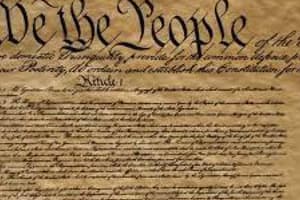Podcast
Questions and Answers
कांग्रेस की भूमिका क्या है?
कांग्रेस की भूमिका क्या है?
- कानून बनाना (correct)
- राष्ट्रपति का चयन करना
- कार्यकारी कार्य संचालित करना
- न्यायिक न्यायपालिका द्वारा कार्य करना
किस व्यक्ति ने सत्ता के विभाजन से संबंधित सिद्धांतों को प्रभावित किया?
किस व्यक्ति ने सत्ता के विभाजन से संबंधित सिद्धांतों को प्रभावित किया?
- उपराष्ट्रपति
- प्रधानमंत्री
- मोंटेस्क्यू (correct)
- महान्यायाधीश
किसकी जिम्मेदारी है कि संघीय सरकार के बजट और वित्त पर प्रभाव डालना?
किसकी जिम्मेदारी है कि संघीय सरकार के बजट और वित्त पर प्रभाव डालना?
- केंद्रीय मंत्रिमंडल
- न्यायिक शाखा
- प्रधानमंत्री
- कांग्रेस (correct)
सम्पूर्ण सत्ता को विभाजित करने के लिए संविधान में कौन-सा सिद्धांत है?
सम्पूर्ण सत्ता को विभाजित करने के लिए संविधान में कौन-सा सिद्धांत है?
केंद्रीय शासन का मुख्य ध्यान किस पर है?
केंद्रीय शासन का मुख्य ध्यान किस पर है?
न्यायिक शाखा किसके लिए महत्वपूर्ण मानी जाती है?
न्यायिक शाखा किसके लिए महत्वपूर्ण मानी जाती है?
सत्ता के मजबूतीकरण से बचने के लिए, हर सरकारी शाखा का क्या होना चाहिए?
सत्ता के मजबूतीकरण से बचने के लिए, हर सरकारी शाखा का क्या होना चाहिए?
संलग्नता की दृष्टि से, प्रशासकीय शाखा किस प्रक्रिया से प्रतिक्रिया प्रस्तुत कर सकती है?
संलग्नता की दृष्टि से, प्रशासकीय शाखा किस प्रक्रिया से प्रतिक्रिया प्रस्तुत कर सकती है?
Checks and Balances क्््््््््््््््््््््््््््(संलग्नता)…
Checks and Balances क्््््््््््््््््््््््््््(संलग्नता)…
Separation of Powers क्््््््््््््््््(समन्वेषण)…
Separation of Powers क्््््््््््््््््(समन्वेषण)…
Flashcards are hidden until you start studying
Study Notes
Unbundling Power: How the Constitution's Separation of Powers Works
In the mind-bending complexities of modern government, it's easy to lose sight of the fundamental principles that underpin our political systems. The Separation of Powers, enshrined in the United States Constitution, is one such foundational principle. This principle is not a throwaway line but a careful design that fosters a healthy balance of power and keeps our government accountable.
The Separation of Powers is not about splitting up our collective responsibilities; it's about ensuring that each branch of government—the legislative, executive, and judicial branches—has its distinct role, preventing any one branch from becoming too powerful. This principle stems from the philosophies of political theorists like Montesquieu, whose ideas were deeply influential in the writing of the U.S. Constitution.
Legislative Branch
The legislative branch—Congress, comprised of the Senate and House of Representatives—is responsible for making laws, approving budgets, and electing the President. This branch is designed to have the power of the purse, meaning it has the ability to raise and spend money. This power helps to ensure that Congress has the ability to oversee and check the other branches, as they have the power to influence their budget and funding.
Executive Branch
The executive branch—the President, Vice President, and the Cabinet—is responsible for enforcing the laws of the United States. The President is tasked with appointing judges and federal officials, negotiating treaties, and serving as the commander-in-chief of the military forces. In essence, the executive branch is focused on the implementation of the laws passed by Congress.
Judicial Branch
The judicial branch—the Supreme Court and other federal courts—is tasked with interpreting laws and resolving disputes. Judges interpret the U.S. Constitution and federal laws, and they serve for life, which helps to ensure their independence from political pressures. The judiciary acts as an important check and balance on the other branches, as its interpretations of the laws can impact their jurisdictions.
Checks and Balances
The Separation of Powers does not exist in a vacuum, but rather as part of the broader framework of checks and balances. Each branch of government is designed to act as a check on the others' powers to prevent any one branch from becoming too powerful or abusing its authority. For example:
- Congress can pass legislation, but the President can veto bills, and Congress can override that veto with a two-thirds majority vote.
- The President has the power to appoint judges, but the Senate must confirm those appointments.
- The judiciary interprets the Constitution and federal laws, but the legislative and executive branches can challenge the courts' decisions through processes like impeachment and appeals.
These checks and balances are meant to preserve the delicate balance of power between the three branches, encouraging open debate, collaboration, and accountability.
Why the Separation of Powers Matters
The Separation of Powers is not merely a legal construct but a political philosophy that has guided the United States since its inception. It helps to ensure that our government remains accountable, transparent, and responsive to the needs and concerns of the people. The principle of Separation of Powers also serves as a reminder that no one branch of government is more important than the others. Instead, each branch has its role and responsibilities, and each is accountable to the people for its actions.
The Separation of Powers is not an impediment to effective governance; rather, it is an essential component of a healthy democracy. It ensures that power remains distributed and balanced, allowing for a more responsive, transparent, and accountable government. As we navigate the complexities of modern governance, the Separation of Powers remains a cornerstone of our political system, helping to keep our government in check and ensuring that it remains responsive to the needs of the people it serves.
Studying That Suits You
Use AI to generate personalized quizzes and flashcards to suit your learning preferences.




